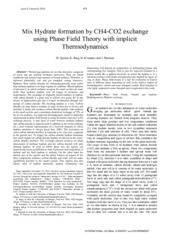| dc.contributor.author | Qasim, M. | |
| dc.contributor.author | Baig, K. | |
| dc.contributor.author | Kvamme, B. | |
| dc.contributor.author | Bauman, J. | |
| dc.date.accessioned | 2017-08-28T12:19:15Z | |
| dc.date.available | 2017-08-28T12:19:15Z | |
| dc.date.issued | 2012 | |
| dc.identifier.issn | 2076-2909 | en_US |
| dc.identifier.issn | 2076-2895 | en_US |
| dc.identifier.uri | https://hdl.handle.net/1956/16416 | |
| dc.description.abstract | Natural gas hydrates are ice-like structures composed of water and gas (mostly methane) molecules. They are found worldwide and contain huge amounts of bound methane. Therefore, it represent potentially vast and yet untapped energy resources. Hydrates from carbon dioxide are thermodynamically more stable than methane hydrate over large regions of condition. Mixed hydrates of structure I, in which methane occupies the small cavities are more stable than methane hydrate over all ranges of pressures and temperatures. The exchange of originally bound methane in hydrate with carbon dioxide is a great way to achieve two goals, the in situ release of hydrocarbon gas and a cleaner environment through safe storage of carbon dioxide. The resulting hydrate is a mix. Carbon dioxide can only replace methane in large cavities due to its size and therefore it forms mix methane-carbon dioxide hydrate with methane in the small cavities and a maximum theoretical exchange of 75% of the in situ methane. An improved thermodynamic model is implicitly implemented in phase field theory to study the kinetic rates due to the exchange process. A thin layer of water between methane hydrate and carbon dioxide is implemented in addition to the initial methane for a more realistic representation of a reservoir situation in which hydrate saturation is always lower than 100%. The nucleation on water-carbon dioxide interface is expected to be very slow compared to the growth rate. To trigger the carbon dioxide hydrate formation four small regions of carbon dioxide hydrate are placed on the watercarbon dioxide interface. The exchange process involves an initial dissociation of methane hydrate and the carbon dioxide will start forming hydrate. In term of Gibbs phase rule the system can theoretically reach equilibrium as limit if pressure and temperature is defined and the final hydrate is uniform. On the other hand the limited size of the system and the initial balance of masses of the three components methane, carbon dioxide and water will not make equilibrium possible in the model system. This implies also that kinetic rates of hydrate formation, hydrate reformation and dissociation will depend on composition of surrounding phases and corresponding free energies. This is also the expected situation in a porous media like a hydrate reservoir, in which the hydrate is in a stationary balance with fluids and typically kept trapped by layers of clay or shale. Phase field theory is a tool for evaluation of kinetic rates of different phase transitions as well as the relative impact of thermodynamic control and mass transport control. Heat transport is very rapid compared to mass transport and is neglected in this work. | en_US |
| dc.language.iso | eng | eng |
| dc.publisher | International Energy and Environment Foundation (IEEF). | en_US |
| dc.relation.ispartof | <a href="http://hdl.handle.net/1956/16353" target="blank">Nano to Micro Scale Modeling of Hydrate Phase Transition Kinetics</a> | en_US |
| dc.rights | Creative Commons Attribution 4.0 License. | eng |
| dc.rights.uri | http://creativecommons.org/licenses/by/4.0/ | eng |
| dc.subject | Phase field theory | eng |
| dc.subject | Natural gas hydrate | eng |
| dc.subject | Hydrodynamics | eng |
| dc.subject | Hydrate exchange | eng |
| dc.title | Mix Hydrate formation by CH4-CO2 exchange using Phase Field Theory with implicit Thermodynamics | en_US |
| dc.type | Peer reviewed | |
| dc.type | Journal article | |
| dc.description.version | publishedVersion | en_US |
| dc.rights.holder | Copyright the authors. | en_US |
| dc.source.journal | International Journal of Energy and Environment | |
| dc.source.40 | 6 | |
| dc.source.14 | 5 | |
| dc.source.pagenumber | 479-487 | |
| dc.subject.nsi | VDP::Matematikk og Naturvitenskap: 400::Fysikk: 430 | en_US |

